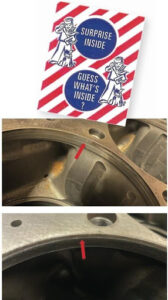




If upper bore erosion is discovered during block inspection, it must be disregarded. It is not a failure mode and the head gasket provides an adequate seal.
The problem occurs when the upper bore diameter of the block gets worn to the point it cannot hold the liner from moving. The liner movement then causes the head gasket to fret into the surface of the cylinder head and the head gasket to fail.
At the time the OE guide was published, had they not considered the wear these engines would experience? Especially as they age, and the engine experiences the countless number of miles put on these blocks. Pictured far right, these four photos are examples of the wear found around the circumference in the upper receiver bores of a high mileage ISX block.
The upper landing of the cylinder liner is fairly narrow in comparison to the mating area of the cylinder block. Since the cylinder liner is a “mid-stop” design, it is held at the lower counter bore and at the top by the head gasket.
The photos shown here are from an ISX engine that failed the head gasket on two cylinders. There was also fretting damage to the cylinder head on all six cylinders.
Pictured below is a rough outline of the construction of the head gasket. At each of the cylinders there is a fire wire, or ring encased by the fire wrap. The crushing force from the cylinder head seals this area of the head gasket to the liner.
When the cylinder liner is not held firmly in place at the top by the cylinder block the liner begins to move with each stroke of the engine. This causes the gasket to fret into the cylinder head, cracking the fire wrap on the head gasket and the gasket soon fails. This is not the gasket’s fault – it has scrubbed against the cylinder head to the point it fails. The clamping force from the cylinder head pushes downward to the lower counter bore in the block and the top of the liner dances around. The gasket is not designed to withstand this type of movement or force.
cracking the fire wrap on the head gasket and the gasket soon fails. This is not the gasket’s fault — it has scrubbed against the cylinder head to the point it fails. The clamping force from the cylinder head pushes downward to the lower counter bore in the block and
I have talked to several machine shops and rebuilders about this condition since the last article and have been told this is becoming a more common occurrence. If severe enough, it requires a custom sleeve or insert to be installed in the block to repair the damaged area. When they install a repair sleeve in the block, the rebuilders tend to use a finish bore size of 6.339″ to 6.340″. Cummins lists a max spec diameter of 6.340″ for this upper area of the liner, but does not publish a spec of the block upper bore diameter. Possibly the movement of the liner or the wear may be seen while the liner is still in the block, but to get an accurate measurement the liners would need to be removed. Without a published spec the acceptable amount of clearance or wear is unknown. A worn diameter of 6.344″ tends to be the max diameter for the block according to the rebuilders I spoke with.
In some ways I was hesitant to publish this article because I do not have an out of the box solution. Without documented specs or procedures for repairing the block damage, the best I have to offer is pointing out a possible problem. Hopefully this information will be useful and fend off a potential failure. With the age, popularity, and huge number of these ISX engines in production, there is no doubt there will be more surprises to come in the ISX crackerjack box.■
Steve Scott joined the service department at lPD in 1982, working with parts, service and sales for a variety of equipment,diesel,and natural gas engines.Since2004, he has been the director of product development and technical support for lPD.For more information, email sscott@ipdparts.com.
If you’re an existing customer and already have a login, click here to find IPD quality parts.
If you would like to find an IPD distributor or become an IPD distributor, please fill out our form.